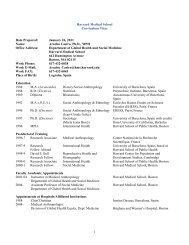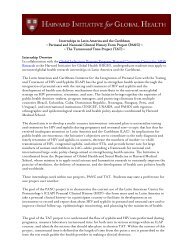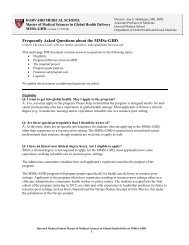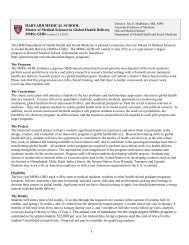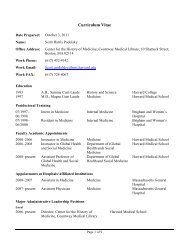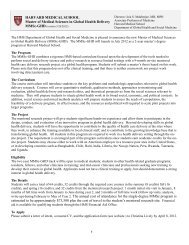Haiti Case Study - The Department of Global Health and Social ...
Haiti Case Study - The Department of Global Health and Social ...
Haiti Case Study - The Department of Global Health and Social ...
You also want an ePaper? Increase the reach of your titles
YUMPU automatically turns print PDFs into web optimized ePapers that Google loves.
6. On the evening <strong>of</strong> 15 January, a 115-person team operating under US Transportation<br />
Comm<strong>and</strong> (TRANSCOM) arrived to help support the airport team. 83 <strong>The</strong> TRANSCOM units<br />
worked with the special tactics squadron to bring in five C-17 cargo planes <strong>of</strong> communication<br />
<strong>and</strong> airstrip management equipment to relieve the congestion <strong>and</strong> restart flights. Within 72<br />
hours, the combined airport teams were able to increase the volume <strong>of</strong> flights h<strong>and</strong>led by the<br />
airport from 30 per day prior to the earthquake, up to 140 flights per day—setting the all-time<br />
record for a single-strip operation in US military history. No accidents occurred <strong>and</strong> this pace<br />
was maintained for three months. 84<br />
7. This technical achievement allowed flights to enter the country; the next challenge was<br />
how to prioritize them. Personnel from response organizations including militaries brought in<br />
to provide security, supplies to support them, tents, medicines, water, in-kind donations,<br />
equipment, diplomats, movie stars, <strong>and</strong> thous<strong>and</strong>s <strong>of</strong> expatriates to be evacuated all needed<br />
to be flown in <strong>and</strong>/or out. Every country <strong>and</strong> organization wanted to prioritize the aid it was<br />
sending <strong>and</strong> in the absence <strong>of</strong> an internationally agreed upon method for prioritization, those<br />
involved in air traffic control were left to figure it out for themselves. Adding to their challenge<br />
was that, in many cases, flights had no manifest, making it impossible to know how they<br />
should be prioritized compared to flights that had sent TRANSCOM its cargo manifests. In<br />
other cases, according to an interview conducted during the fieldwork for this case, flights<br />
misrepresented their cargo to gain priority entry.<br />
8. Although the US government <strong>and</strong> military partnered with the <strong>Haiti</strong>an government, <strong>and</strong><br />
later with MINUSTAH, on flight prioritization, some global response actors disagreed with the<br />
airport team’s decisions. <strong>The</strong> prioritization by the US military <strong>of</strong> “military” supplies in the<br />
initial three days <strong>of</strong> the response quickly created the impression that the US was, as some<br />
exasperated <strong>of</strong>ficials expressed it, “occupying <strong>Haiti</strong>”—even though the supplies were <strong>of</strong>ten<br />
for relief. 85 As flights started arriving with political leaders, US soldiers <strong>and</strong> their equipment,<br />
<strong>and</strong> celebrities, Médecins Sans Frontières, which had a flight <strong>of</strong> critical supplies diverted from<br />
the airport to Miami, delivered one <strong>of</strong> the more public criticisms <strong>of</strong> the US military: “What is<br />
unacceptable to us is the priorities,” the group’s spokesperson stated to the media. 86<br />
9. <strong>The</strong> participants in this study involved with airstrip l<strong>and</strong>ing choices described having to<br />
take prioritization decisions based on little data <strong>and</strong> having to accommodate the conflicting<br />
agendas <strong>of</strong> multiple stakeholders. For example, in the case <strong>of</strong> the Médecins Sans Frontières<br />
(MSF) plane, interviewed decision makers reported that the plane—which was low on fuel<br />
<strong>and</strong> thus had to either l<strong>and</strong> or divert to another airport—could not l<strong>and</strong> because there was<br />
literally nowhere to put the plane at the time they were slotted to arrive because several<br />
aircraft had failed to take <strong>of</strong>f. 87<br />
10. Problems prioritizing flights constituted significant distractions for <strong>Haiti</strong>an health system<br />
leadership as well. “I would <strong>of</strong>ten have to interrupt planning meetings to go <strong>and</strong> welcome<br />
various dignitaries on the tarmac, or negotiate political disagreements,” one participant<br />
remarked. 88 Another noted that having to justify why they had allowed the US military to<br />
control the airport took up significant amounts <strong>of</strong> time <strong>and</strong> energy. 89<br />
11. After several weeks the US State <strong>Department</strong> <strong>and</strong> US SOUTHCOM, with UNDAC <strong>and</strong><br />
World Food Programme (WFP) input evolved a flight slot allocation system where requests<br />
for l<strong>and</strong>ing slots were processed by a call in system at US SOUTHCOM. Each requester<br />
received a l<strong>and</strong>ing slot time. If the time was inappropriate the requester could then plan<br />
another way to get goods into the country. In terms <strong>of</strong> balancing competing needs, a system<br />
<strong>of</strong> thirds was organized such that a third <strong>of</strong> the flights were for NGOs, a third for diplomats<br />
<strong>and</strong> a third for military supplies. 90 While this system was more transparent, it was not “needs<br />
based” or driven by priorities noted on the ground. For their part, the <strong>Haiti</strong>an <strong>of</strong>ficials<br />
attempting to provide guidance to the US military about which planes to l<strong>and</strong> based on what<br />
supplies were needed in the field were almost totally in the dark.<br />
A-2







